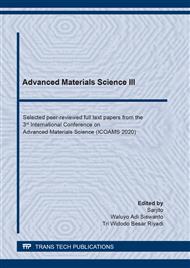[1]
BPS-Statistic Indonesia, Executive Summary 2018 Harvested Area and Rice Production in Indonesia" [Online]. Available Online: https://www.bps.go.id/publication/2018/12/21/7faa198f77150c12c31df395/ringkasan-eksekutif-luas-panen-dan-produksi-beras-di-indonesia-2018.html. [Accessed: September 26, 2020].
Google Scholar
[2]
A. Kumar, B. Sengupta, D. Dasgupta, T. Mandal, and S. Datta S, Recovery of value added products from rice husk ash to explore an economic way for recycle and reuse of agricultural waste, Rev. Environ. Sci. Biotechnol, 15 (2016), 47-65.
DOI: 10.1007/s11157-015-9388-0
Google Scholar
[3]
R. Pode, Potential applications of rice husk ash waste from rice husk biomass power plant, Renew. Sustain. Energy Rev, 53 (2016), 1468-1485.
DOI: 10.1016/j.rser.2015.09.051
Google Scholar
[4]
P N Babaso and H. Sharanagouda, Rice husk and its applications: Review, Int. J. Curr. Micro. and App. Sci, 6 (10) (2017), 1144-1156.
DOI: 10.20546/ijcmas.2017.610.138
Google Scholar
[5]
J. S. Lim, Z. Abdul Manan, S. R. Wan Alwi, and H. Hashim, A review on utilisation of biomass from rice industry as a source of renewable energy", Renew. Sustain. Energy Rev, 16 (2012), 3084-3094.
DOI: 10.1016/j.rser.2012.02.051
Google Scholar
[6]
D.S. Chaudhary, and M.C Jollands, Characterization studies of rice hull ash, J. Appl. Polym. Sci, 93 (1) (2004), 1-8.
Google Scholar
[7]
H. Yang, B. Liu, Y. Chen, B. Li, and H. Chen, Influence of Inherent Silicon and Metals in Rice Husk on the Char Properties and Associated Silica Structure. Energy Fuels, 29 (2015), 7327-7334.
DOI: 10.1021/acs.energyfuels.5b01617
Google Scholar
[8]
S. Chandrasekhar, K. Satyanarayana, P. Pramada, P. Raghaven, and T. Gupta, Review processing, properties and applications of reactive silica from rice-husk – an overview, J. Mater .Sci, 38(15) (2003), 3159-3168.
DOI: 10.1002/chin.200406243
Google Scholar
[9]
S. Chandrasekhar, P. N. Pramada, and L. Praveen, Effect of organic acid treatment on the properties of rice husk silica, J. Mater. Sci, 40 (2005), 6535-6544.
DOI: 10.1007/s10853-005-1816-z
Google Scholar
[10]
I. J. Fernandes, D. Calheiro, A.G. Kieling, C.A.M. Moraes, T.L.A.C Rocha, F.A. Brehm, and R.C.E. Modolo, Characterization of rice husk ash produced using different biomass combustion techniques for energy, Fuel, 165 (2016), 351-359.
DOI: 10.1016/j.fuel.2015.10.086
Google Scholar
[11]
N. Yalçin, and V. Sevinç, Studies on silica obtained from rice husk, Ceram. Int, 27 (2001), 219-224.
DOI: 10.1016/s0272-8842(00)00068-7
Google Scholar
[12]
N. Soltani, A. Bahrami, M.I. Pech-Canul, and L.A. González, Review on the physicochemical treatments of rice husk for production of advanced materials, Chem. Eng. J, 264 (2015), 899-935.
DOI: 10.1016/j.cej.2014.11.056
Google Scholar
[13]
Y. Shen, Rice husk silica derived nanomaterials for sustainable applications, Renew. Sustain. Energy Rev, 80 (2017), 453-466.
DOI: 10.1016/j.rser.2017.05.115
Google Scholar
[14]
X.G. Chen, S.S. Lv, P.P. Zhang, L. Zhang, and Y. Ye, Thermal destruction of rice hull in air and nitrogen, J. Therm. Anal. Calorim, 104 (2011), 1055-1062.
DOI: 10.1007/s10973-010-1201-2
Google Scholar
[15]
D. Schneider, S. Wassersleben, M. Weiß, R. Denecke, A. Stark, and D. Enke, A generalized procedure for the production of high-grade, porous biogenic silica. Waste Biomass Valor, 37 (2018), 1-15.
DOI: 10.1007/s12649-018-0415-6
Google Scholar
[16]
J.Umeda, and K. Kondoh, High-purification of amorphous silica originated from rice husks by combination of polysaccharide hydrolysis and metallic impurities removal, Ind. Crops. Prod. 32 (2010), 539-544.
DOI: 10.1016/j.indcrop.2010.07.002
Google Scholar
[17]
J.H. Lee, J.H. Kwon, J.W. Lee, H.S. Lee, J.H. Chang, and B.-I, Sang, Preparation of high purity silica originated from rice husks by chemically removing metallic impurities, J. Ind. Eng. Chem, 50 (2017), 79-85.
DOI: 10.1016/j.jiec.2017.01.033
Google Scholar
[18]
H. Beidaghy Dizaji, T. Zeng, I. Hartmann, D. Enke, T. Schliermann, V. Lenz, and M. Bidabadi, Generation of high quality biogenic silica by combustion of rice husk and rice straw combined with pre- and post-treatment strategies- A Review. Appl. Sci. vol . 9 (6) (2019), 1-27.
DOI: 10.3390/app9061083
Google Scholar
[19]
R. Yuvakkumar , V. Elango , V. Rajendran, and N. Kannan , High-purity nano silica powder from rice husk using a simple chemical method", J. Exp. Nanoscience, , 9 (3) (2012), 1-10.
DOI: 10.1080/17458080.2012.656709
Google Scholar
[20]
J. Umeda, and K. Kondoh, High-purity amorphous silica originated in rice husks via carboxylic acid leaching process, J. Mater. Sci. 43(22) (2008), pp.7084-7090.
DOI: 10.1007/s10853-008-3060-9
Google Scholar
[21]
I.B. Ugheoke, and O. Mamat, A critical assessment and new research directions of rice husk silica processing methods and properties, Maejo Int. J. Sci. and Tech, 6 (3) (2012), pp.430-448.
Google Scholar
[22]
J. Shen, X. Liu, S. Zhu, H. Zhang, and J. Tan, Effects of calcination parameters on the silica phase of original and leached rice husk ash, Mater. Lett. 65 (2011), 1179–1183.
DOI: 10.1016/j.matlet.2011.01.034
Google Scholar
[23]
V.B. Carmona, R.M. Oliveira, W.T.L. Silva, L.H.C. Mattoso, and J.M. Marconcini, Nanosilica from rice husk: extraction and characterization, Ind. Crop. Prod. 43 (2013), 291-296.
DOI: 10.1016/j.indcrop.2012.06.050
Google Scholar
[24]
P.K. Jal, M. Sudarshan, A. Saha, S. Patel, and B.K. Mishra, Synthesis and characterization of nanosilica prepared by precipitation method, Colloids Surf. A: Physicochem. Eng. Asp, 240 (1-3) (2004), 173-178.
DOI: 10.1016/j.colsurfa.2004.03.021
Google Scholar
[25]
T.H. Liou, and C.C. Yang, Synthesis and surface characteristics of nanosilica produced from alkali-extracted rice husk ash, Mater. Sci. Eng.: B, 176 (2011), 521-529.
DOI: 10.1016/j.mseb.2011.01.007
Google Scholar
[26]
V.H. Le, C.N.H. Thuc, and H.H. Thuc, Synthesis of silica nanoparticles from Vietnamese rice husk by sol–gel method, Nanoscale Res. Lett, 8 (2013), 58.
DOI: 10.1186/1556-276x-8-58
Google Scholar
[27]
J. Athinarayanan, V.S. Periasamy, M. Alhazmi, K.A. Alatiah, and A.A. Alshatwi, Synthesis of biogenic silica nanoparticles from rice husks for biomedical applications, Ceram. Int. 41 (2015), 275-281.
DOI: 10.1016/j.ceramint.2014.08.069
Google Scholar
[28]
T.H. Liou, Preparation and characterization of nano-structured silica from rice husk, Mater. Sci. Eng.: A, 364 (2004), 313-323.
DOI: 10.1016/j.msea.2003.08.045
Google Scholar


